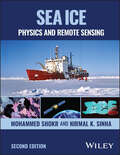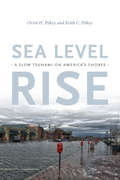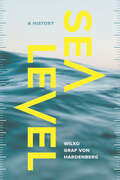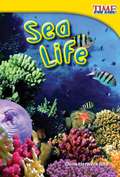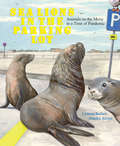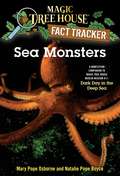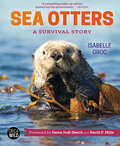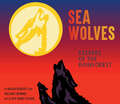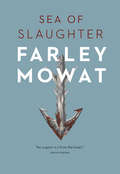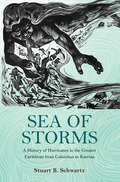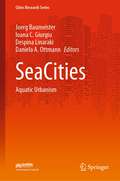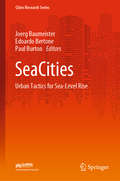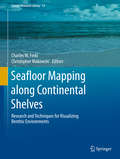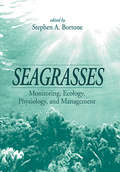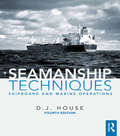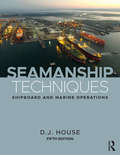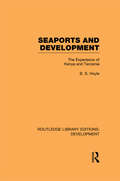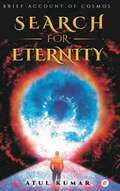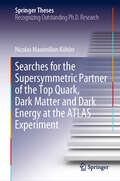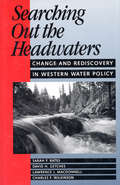- Table View
- List View
Sea Ice: Physics and Remote Sensing (Geophysical Monograph Ser. #209)
by Nirmal K. Sinha Mohammed ShokrSEA ICE The latest edition of the gold standard in sea ice references In the newly revised second edition of Sea Ice: Physics and Remote Sensing, a team of distinguished researchers delivers an in-depth review of the features and structural properties of ice, as well as the latest advances in geophysical sensors, ice parameter retrieval techniques, and remote sensing data. The book has been updated to reflect the latest scientific developments in macro- and micro-scale sea ice research. For this edition, the authors have included high-quality photographs of thin sections from cores of various ice types, as well as a comprehensive account of all major field expeditions that have systematically surveyed sea ice and its properties. Readers will also find: A thorough introduction to ice physics and physical processes, including ice morphology and age-based structural features Practical discussions of radiometric and radar-scattering observations from sea ice, including radar backscatter and microwave emission The latest techniques for the retrieval of sea ice parameters from space-borne and airborne sensor data New chapters on sea ice thermal microwave emissions and on the impact of climate change on polar sea ice Perfect for academic researchers working on sea ice, the cryosphere, and climatology, Sea Ice: Physics and Remote Sensing will also benefit meteorologists, marine operators, and high-latitude construction engineers.
Sea Level Rise: A Slow Tsunami on America's Shores
by Orrin H. Pilkey Keith C. PilkeyThe consequences of twenty-first-century sea level rise on the United States and its nearly 90,000 miles of shoreline will be immense: Miami and New Orleans will disappear; many nuclear and other power plants, hundreds of wastewater plants and toxic waste sites, and oil production facilities will be at risk; port infrastructures will need to be raised; and over ten million Americans fleeing rising seas will become climate refugees. In Sea Level Rise Orrin H. Pilkey and Keith C. Pilkey argue that the only feasible response along much of the U.S. shoreline is an immediate and managed retreat. Among many topics, they examine sea level rise's effects on coastal ecosystems, health, and native Alaskan coastal communities. They also provide guidelines for those living on the coasts or planning on moving to or away from them, as well as the steps local governments should take to prepare for this unstoppable, impending catastrophe.
Sea Level: A History (Oceans in Depth)
by Wilko Graf HardenbergTraces a commonplace average—sea level—from its origins in charting land to its emergence as a symbol of global warming. News reports warn of rising sea levels spurred by climate change. Waters inch ever higher, disrupting delicate ecosystems and threatening island and coastal communities. The baseline for these measurements—sea level—may seem unremarkable, a long-familiar zero point for altitude. But as Wilko Graf von Hardenberg reveals, the history of defining and measuring sea level is intertwined with national ambitions, commercial concerns, and shifting relationships between people and the ocean. Sea Level provides a detailed and innovative account of how mean sea level was first defined, how it became the prime reference point for surveying and cartography, and how it emerged as a powerful mark of humanity’s impact on the earth. With Hardenberg as our guide, we traverse the muddy spaces of Venice and Amsterdam, the coasts of the Baltic Sea, the Panama and Suez canals, and the Himalayan foothills. Born out of Enlightenment studies of physics and quantification, sea level became key to state-sponsored public works, colonial expansion, Cold War development of satellite technologies, and recognizing the climate crisis. Mean sea level, Hardenberg reveals, is not a natural occurrence—it has always been contingent, the product of people, places, politics, and evolving technologies. As global warming transforms the globe, Hardenberg reminds us that a holistic understanding of the ocean and its changes requires a multiplicity of reference points. A fascinating story that revises our assumptions about land and ocean alike, Sea Level calls for a more nuanced understanding of this baseline, one that allows for new methods and interpretations as we navigate an era of unstable seas.
Sea Life
by Dona Herweck RiceFrom tide pools to the ocean, the sea is filled with amazing lifeforms! Early readers will be engaged from beginning to end with informational text, vivid photos, and a picture glossary of marine animals.
Sea Lions in the Parking Lot: Animals On The Move In A Time Of Pandemic
by Lenora TodaroWhat would happen if people all around the world stayed inside, away from animals' habitats? Twelve fascinating real-life stories of creatures around the globe who reclaimed their habitat during the COVID-19 quarantine show animal lovers and aspiring citizen scientists how to help wildlife by fighting habitat loss. A Junior Library Guild selection. With the skies, roads, and waterways clear and quiet during the COVID-19 pandemic, the natural world seemed to return to an earlier, wilder state. Animals crossed boundaries that people had set over centuries, reclaiming ancient habitats. From sea lions who clambered into a parking lot in Argentina to deer who wandered in a Japanese subway to lions lounging in the middle of South African roads to kangaroos who bounced through a shopping district in Australia, this thoroughly researched, stunningly illustrated book tells the stories of these newly footloose creatures -- and describes what the COVID-19 "pause" taught scientists about how ecosystems and wildlife can rebound if the right environmental conditions are achieved.
Sea Monsters (Magic Tree House Fact Tracker #17)
by Mary Pope Osborne Sal Murdocca Natalie Pope BoyceHow are an octopus and a squid different? What kinds of creatures live in the deepest abyss of the ocean? What do scientists say some legendary sea monsters really are? Find out the answers to these questions and more in this Magic Tree House Fact Tracker: Sea Monsters.
Sea Otters: A Survival Story (Orca Wild #3)
by Isabelle GrocSea otters once ruled the Pacific Ocean, but the fur trade of the eighteenth and nineteenth centuries brought this predator to near extinction. Today they’re slowly coming back from the brink, and scientists are learning more about their pivotal role as one of nature’s keystone species. This book looks at the history, biology, behavior and uncertain future of sea otters. Author and photojournalist Isabelle Groc takes us into the field: watching sea otter rafts off the British Columbia coast from a kayak, exploring what makes their fur coats so special, understanding how their voracious appetites are helping kelp forests thrive and, ultimately, learning how sea otters are leaving their mark (or paws) on every part of the ecosystem. They might be one of the most adorable creatures in the ocean, but kids will discover how their survival is key to a rich, complex and connected ecosystem.
Sea Sick
by Alanna MitchellAll life -- whether on land or in the sea -- depends on the oceans for two things:* Oxygen. Most of Earth's oxygen is produced by phytoplankton in the sea. These humble, one-celled organisms, rather than the spectacular rain forests, are the true lungs of the planet.* Climate control. Our climate is regulated by the ocean's currents, winds, and water-cycle activity.Sea Sick is the first book to examine the current state of the world's oceans -- the great unexamined ecological crisis of the planet -- and the fact that we are altering everything about them; temperature, salinity, acidity, ice cover, volume, circulation, and, of course, the life within them.Alanna Mitchell joins the crews of leading scientists in nine of the global ocean's hotspots to see firsthand what is really happening around the world. Whether it's the impact of coral reef bleaching, the puzzle of the oxygen-less dead zones such as the one in the Gulf of Mexico, or the shocking implications of the changing Ph balance of the sea, Mitchell explains the science behind the story to create an engaging, accessible yet authoritative account.From the Hardcover edition.
Sea Turtles
by Gail Gibbons<p>Dive into the world's oceans to explore the dangerous lives of one of the oldest living animals. <p>Descended from enormous prehistoric creatures, sea turtles are fascinating. Hatched from eggs smaller than a baseball, some can grow to weigh over a thousand pounds. Once adults, they can live to be around 100 years old. And when it's time to nest, they migrate more than 1,000 miles. <p>With colorful, clear illustrations and straightforward text, Gail Gibbons introduces the eight kinds of sea turtles living in the ocean today. Learn the similarities and differences with labeled diagrams and experience the hatching of the tiny turtle babies with detailed illustrations. This updated edition now includes the most up-to-date information about these beloved reptiles, as reviewed by an expert vetter in the field of herpetology. <p>Sea Turtles also gives young readers an accessible overview of how the lives of these large reptiles have become threatened and discusses the conservation efforts currently taking place. Ideal for aspiring oceanographers, this brightly-illustrated book is a perfect introduction to the subject.</p>
Sea Wolves: Keepers of the Rainforest
by Melanie Crowder MEGAN BENEDICTThis lyrical, stunningly illustrated book explores the sea wolf—an apex marine mammal evolved from the gray wolf—as it navigates the coastline, eats seafood, and lives its extraordinary, unusual life.Sea Wolves: Keepers of the Rainforest is the astonishing story of a wolf species that calls the shores of western Canada and southeastern Alaska home. Here, wolves crack clams, feast on fish roe, swipe salmon from rivers, and swim miles between islands—as long observed by the First Nations communities that have lived alongside them for thousands of years. However, with the rise of industrial logging, pipeline projects, and other threats, sea wolves face a troubled future. Wildlife experts and First Nations members agree: these majestic creatures are a vital part of the ecosystem and need to be protected.Through beautiful verse and striking illustrations, Sea Wolves captures the fascinating life of an animal with great cultural and scientific significance—one that will inspire awe in young readers.
Sea of Slaughter
by Farley MowatThe northeastern seaboard of North America, extending from Labrador to Cape Cod, was the first region of North America to suffer from human exploitation. <P><P>Farley Mowat informs the extensive historical and biological research with his direct experience living in and observing this region. When it was first published nearly thirty years ago, Sea of Slaughter served as a catalyst for environment reform, raising awareness of the decline and destruction of marine and coastal species. Today, it remains a prescient and chilling environmental classic, serving, now as ever, as a haunting reminder of the impact of human interest on the natural world.
Sea of Storms
by Stuart B. SchwartzThe diverse cultures of the Caribbean have been shaped as much by hurricanes as they have by diplomacy, commerce, or the legacy of colonial rule. In this panoramic work of social history, Stuart Schwartz examines how Caribbean societies have responded to the dangers of hurricanes, and how these destructive storms have influenced the region's history, from the rise of plantations, to slavery and its abolition, to migrations, racial conflict, and war.Taking readers from the voyages of Columbus to the devastation of Hurricane Katrina, Schwartz looks at the ethical, political, and economic challenges that hurricanes posed to the Caribbean's indigenous populations and the different European peoples who ventured to the New World to exploit its riches. He describes how the United States provided the model for responding to environmental threats when it emerged as a major power and began to exert its influence over the Caribbean in the nineteenth century, and how the region's governments came to assume greater responsibilities for prevention and relief, efforts that by the end of the twentieth century were being questioned by free-market neoliberals. Schwartz sheds light on catastrophes like Katrina by framing them within a long and contentious history of human interaction with the natural world.Spanning more than five centuries and drawing on extensive archival research in Europe and the Americas, Sea of Storms emphasizes the continuing role of race, social inequality, and economic ideology in the shaping of our responses to natural disaster.Some images inside the book are unavailable due to digital copyright restrictions.
SeaCities: Aquatic Urbanism (Cities Research Series)
by Joerg Baumeister Daniela A. Ottmann Ioana C. Giurgiu Despina LinarakiThis book highlights the research outcome of Cities Research Institute's SeaCities group at Griffith University and a panel with the same title which took place at the World Expo in Dubai 2021/22 supported by the UN. It reflects on topics which are relevant for a future aquatic urbanism like the evolution of a taxonomy for aquatic urbanism, island and ecological wetland development, the planning aspects of seascapes, as well as drivers for floating communities and aquacultural urbanism. The book broadens the perspective of the previous book "SeaCities: Urban Tactics for Sea-Level Rise" published in 2021 from a terrestrial towards an amphibious and aquatic understanding of future city development.
SeaCities: Urban Tactics for Sea-Level Rise (Cities Research Series)
by Joerg Baumeister Edoardo Bertone Paul BurtonThis book presents and discusses a strategy which includes four approaches to dealing with the risk of sea-level rise and other water hazards. It also offers opportunities for cities to explore urban extensions such as marine estates, aquatic food production systems, new sea related industries, maritime transport developments, new oceanic tourist attractions, and the designation of additional coastal ecological zones. The urban interface between Sea and Cities generates, therefore, both burning issues and valuable opportunities and raises the question of whether it is possible to solve the former by exploiting the latter?
Seafloor Mapping along Continental Shelves
by Charles W. Finkl Christopher MakowskiThis university-level reference work covers a range of remote sensing techniques that are useful for mapping and visualizing benthic environments on continental shelves. Chapters focus on overviews of the history and future of seafloor mapping techniques, cartographical visualisation and communication of seafloor mapping, and practical applications of new technologies. Seabed mapping is referenced by high-resolution seismic methods, sidescan sonar, multibeam bathymetry, satellite imagery, LiDAR, acoustic backscatter techniques, and soundscape ecology monitoring, use of autonomous underwater vehicles, among other methods. The wide breadth of subjects in this volume provides diversified coverage of seafloor imaging. This collection of modern seafloor mapping techniques summarizes the state of the art methods for mapping continental shelves.
Seagrasses: Monitoring, Ecology, Physiology, and Management
by Stephen A. BortoneSeagrasses are becoming widely used as in situ indicators of the relative health and condition of subtropical and tropical estuarine ecosystems. To permit meaningful management of our estuaries, there is clearly a need to develop and refine ways of effectively monitoring and assessing seagrasses.Seagrasses: Monitoring, Ecology, Physiology, and
Seagulls Soar
by April Pulley SayreAward-winning author April Pulley Sayre explores everyone's favorite impertinent birds--seagulls--examining their intelligence, behavior, and surprisingly widespread habitat in this STEAM nonfiction picture book.Did you know that seagulls sometimes live far from the sea--near a lake or farm, or even in a desert? Or that they are omnivores, eating everything from fish and clams, to grasshoppers and mice, and even to blueberries? Or that they dance? These birds are full of surprises! Join April Pulley Sayre as she poetically describes the curious behaviors and wide-ranging habitats of one of the most graceful birds to soar in the sky.
Seahorses: A Life-Size Guide to Every Species
by Sara A. LourieAbsolutely captivating creatures, seahorses seem like a product of myth and imagination rather than of nature. They are small, elusive, and are named for their heads, which are shaped like miniature ponies with tiny snouts. They swim slowly upright by rapidly fanning their delicate dorsal fin, coil their tails to anchor themselves in a drift, and spend days in a dancing courtship. Afterward, it is the male who carries the female's eggs in his pouch and hatches the young. Seahorses are found worldwide, and they are highly sensitive to environmental destruction and disturbance, making them the flagship species for shallow-water habitat conservation. They are as ecologically important as they are beautiful. Seahorses celebrates the remarkable variety of seahorse species as well as their exquisiteness. 57 species, including seadragons and pipefish, are presented in lush, life-size photographs alongside descriptive drawings, and each entry includes detailed and up-to-date information on natural history and conservation. Sara Lourie, a foremost expert on seahorse taxonomy, presents captivating stories of species that range from less than an inch to over a foot in height, while highlighting recent discoveries and ecological concerns. Accessibly written, but comprehensive in scope, this book will be a stunning and invaluable reference on seahorse evolution, biology, habitat, and behavior. Masters of camouflage and rarely seen, seahorses continue to be a fascinating subject of active research. This visually rich and informative book is certain to become the authoritative guide to these charming and unusual wonders of the sea, beloved at aquariums the world over.
Seamanship Techniques: Shipboard and Marine Operations (4th Edition)
by D. J. House<p>Ideal for Merchant Navy Officers from Cadet rank to Master Mariner, the fourth edition of this book is in full colour, and has been updated to include more information on topics as diverse as electronic navigation and AIS technology whilst still including essential information on subjects such as safety at sea, rescue operations, watch keeping duties and pollution control. Used by training establishments around the world, this is the only reference to both shipboard practice and ship operations that seafarers will need. <p>Includes modern techniques such as electronic navigation and AIS technology. Comprehensive coverage of the knowledge required by seafarers of all ranks. Covers all the knowledge required to take readers from Cadet to Master rank.</p>
Seamanship Techniques: Shipboard and Marine Operations (Pegasus Library)
by D.J. HouseIdeal for Merchant Navy Officers from Cadet rank to Master Mariner, the fifth edition of this highly respected book is in full colour, and has been updated to include more information on topics as diverse as electronic navigation and AIS technology whilst still including essential information on subjects such as safety at sea, rescue operations, watchkeeping duties and pollution control. It covers international standards and works well on courses throughout the world. Seamanship Techniques is written for serving mariners and nautical students from cadet to master level, studying for professional marine qualifications under the International Maritime Organization as per STCW requirements. Used by training establishments around the world, this best seller is the only reference to both shipboard practice and ship operations that seafarers will need.
Seaports and Development: The Experience of Kenya and Tanzania (Routledge Library Editions: Development #69)
by B. S. HoyleThis book, originally published in 1983, demonstrates the importance of seaports in the growth of less-developed countries. The author focuses on the character of port activity within the context of transport systems and regional economic planning. General principles of port development are illustrated by detailed reference to one Third World port group, that of the Indian Ocean coasts of Kenya and Tanzania. The objective is not merely to illustrate the character of one specific group of ports, but to demonstrate methods of analysis and to underline the crucial role of ports in the development process.
Search For Eternity: Brief Account of Cosmos
by Atul KumarThe book attempts to present a new perspective to its readers for looking self and surrounding world. It tries to tell that we humans, all living beings and all non living things, moon, planets, stars, galaxies are made of the same matter particles. How everything is cosmically connected? How all matter, all space, all energy has been formed during the cosmic evolution? What are different ways to decipher such understanding? What are the scientific principles, laws and theories which help in explaining and understanding them? What are the tools and techniques which enable us to look, to experience and to test them? How vast is the universe and how small and insignificant we are? In short, the book provides a cosmic perspective for self realization to mankind. The Bhagavad Gita mentions one of the paths for salvation as Gyan Yoga (the path of knowledge for self realization). This book is a step forward in that direction. While giving brief account of cosmos, the book tries to soften human ego and expects its readers to keep our earthly differences aside and realize our cosmic connection.
Searches for Supersymmetric Particles in Final States with Multiple Top and Bottom Quarks with the Atlas Detector (Springer Theses)
by Chiara RizziThis PhD thesis documents two of the highest-profile searches for supersymmetry performed at the ATLAS experiment using up to 80/fb of proton-proton collision data at a center-of-mass energy of 13 TeV delivered by the Large Hadron Collider (LHC) during its Run 2 (2015-2018). The signals of interest feature a high multiplicity of jets originating from the hadronisation of b-quarks and large missing transverse momentum, which constitutes one of the most promising final state signatures for discovery of new phenomena at the LHC. The first search is focused on the strong production of a pair of gluinos, with each gluino decaying into a neutralino and a top-antitop-quark pair or a bottom-antibottom-quark pair. The second search targets the pair production of higgsinos, with each higgsino decaying into a gravitino and a Higgs boson, which in turn is required to decay into a bottom-antibottom-quark pair. Both searches employ state-of-the-art experimental techniques and analysis strategies at the LHC, resulting in some of the most restrictive bounds available to date on the masses of the gluino,neutralino, and higgsino in the context of the models explored.
Searches for the Supersymmetric Partner of the Top Quark, Dark Matter and Dark Energy at the ATLAS Experiment (Springer Theses)
by Nicolas Maximilian KöhlerAstrophysical observations implying the existence of Dark Matter and Dark Energy, which are not described by the Standard Model (SM) of particle physics, have led to extensions of the SM predicting new particles that could be directly produced at the Large Hadron Collider (LHC) at CERN. Based on 2015 and 2016 ATLAS proton-proton collision data, this thesis presents searches for the supersymmetric partner of the top quark, for Dark Matter, and for DarkEnergy, in signatures with jets and missing transverse energy.Muon detection is key to some of the most important LHC physics results, including the discovery of the Higgs boson and the measurement of its properties. The efficiency with which muons can be detected with the ATLAS detector is measured using Z boson decays. The performance of high-precision Monitored Drift Tube muon chambers under background rates similar to the ones expected for the High Luminosity-LHC is studied.
Searching Out the Headwaters: Change And Rediscovery In Western Water Policy
by Sarah F. Bates Charles F. Wilkinson Lawrence Macdonnell David H. GetchesTo the uninitiated, water policy seems a complicated, hypertechnical, and incomprehensible subject: a tangle of engineering jargon and legalese surrounding a complex, delicate, and interrelated structure. Decisions concerning the public's waters involve scant public participation, and in such a context, reform seems risky at best. Searching Out the Headwaters addresses that precarious situation by providing a thorough and straightforward analysis of western water use and the outmoded rules that govern it. The authors begin by tracing the history and evolution of the uses of western water. They describe the demographic and economic changes now occurring in the region, and identify the many communities of interest involved in all water-use issues. After an examination of the central precepts of current water policy, along with their original rationale and subsequent evolution, they consider the reform movement that has recently begun to emerge. In the end, the authors articulate the foundations for a water policy that can meet the needs of the new West and discuss the various means for effectively implementing such a policy, including market economics, regulation, the broad-based use of scientific knowledge, and open and full public participation.
